THERE ain’t no Starbucks, fancy chocolate makers, chi-chi restaurants, velvet-rope nightclubs with 300-pound bouncers, 2-million-dollar condos, Fairways, Ikeas, hardly any IPods…just a lot of jewelry stores. Must be two to a block. Just a lot of NYC’s most intriguing architecture alternating with some of the most godawfulest you can imagine, and sprinkle in some items left over from the Truman administration and you’ve got Fulton Street from the eastern edge of Fort Greene through Bedford-Stuyvesant and on to the tangled, intertwined elevated train complex in East New York.
On this trip I was accompanied by:
![]() Mike Epstein’s Satanslaundromat with more Fulton Street antics
Mike Epstein’s Satanslaundromat with more Fulton Street antics
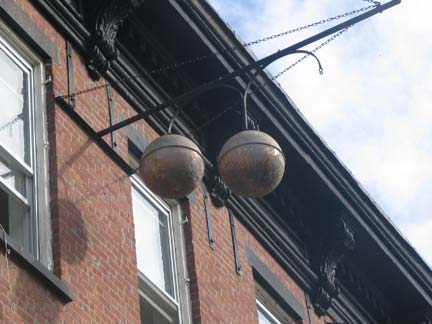
Two balls is all you really need. This pawnbroker’s sign has lost one along the way. The three golden balls of the pawnbroker have their origins in the medieval Medici banking family’s coat of arms. The word itself comes from the Latin term “patinum” meaning clothing. In medieval times the principle assets people had were their clothes and they borrowed money by “pawning” their clothing.
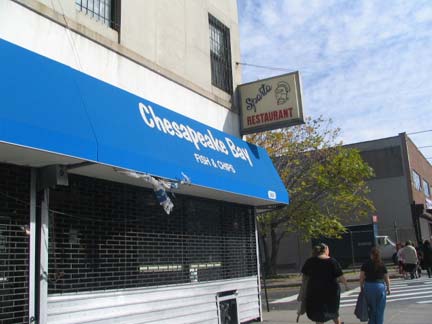
Two incarnations of the same restaurant.
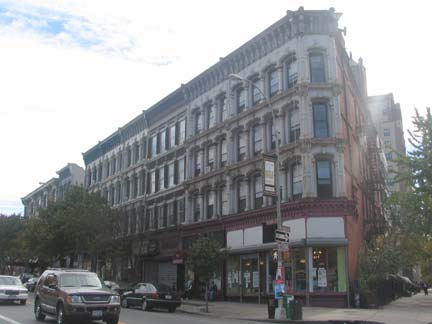
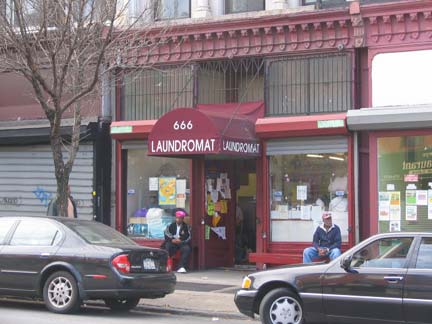
Cast-iron fronted building at Fulton and S. Elliott. RIGHT: Hey, where have I seen that place before?
Fulton Street’s numbering system is slightly funky. The south side house numbers are lower than the north side by about 30. This slowly straightens itself out the further east you proceed, so the south side catches up at about Albany Avenue.
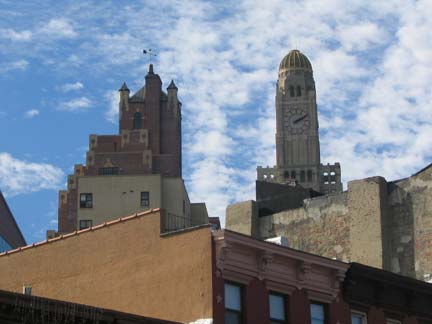
The Williamsburgh Savings Bank building, in 2012 Brooklyn’s 2nd tallest, doesn’t need much introduction, but the building to its left which looks almost as tall (only because of perspective) is 67 Hanson Place, an apartment tower.
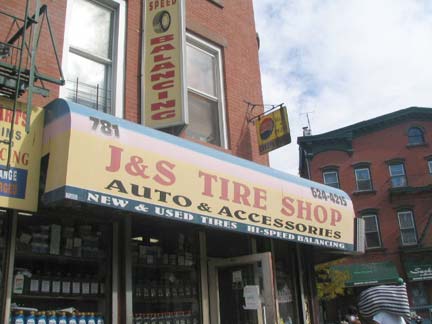
OK, an auto parts shop at Fulton and South Elliott…but what’s that little sign above the awning…?
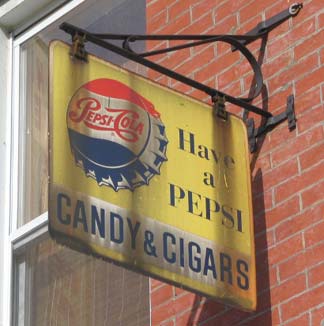
Good gosh!
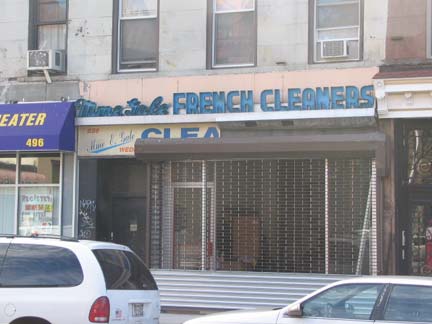
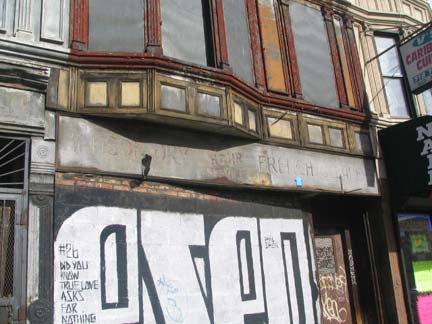
Two French cleaners, each with a superannuated sign. The one on the right is much older and has been reclaimed by oxidation and graffitists.
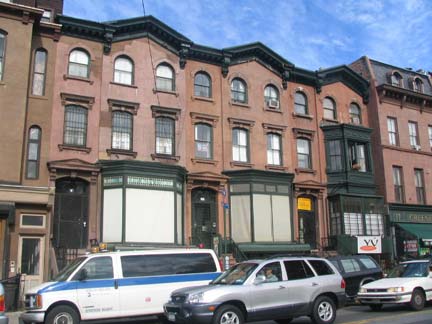
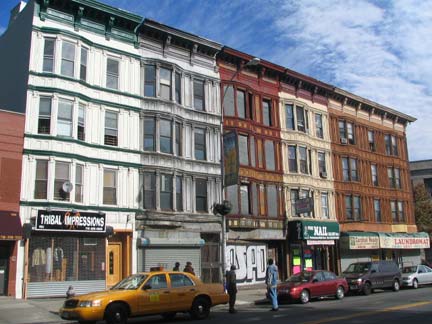
Building fronts on Fulton near Carlton and Clinton Avenues

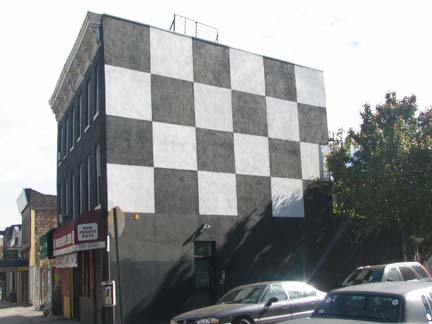
We are in the southern reaches of Clinton Hill when we reach Clinton and Waverly Avenues. Waverly was originally a lane fronting stables for the neighborhood’s near-palatial brownstone mansions. Not much of the region’s magnificence can be seen from Fulton, but there are occasional glimpses.
The exposed side of this taxpayer building has been meticulously maintained as a checker or chess-board for some years.
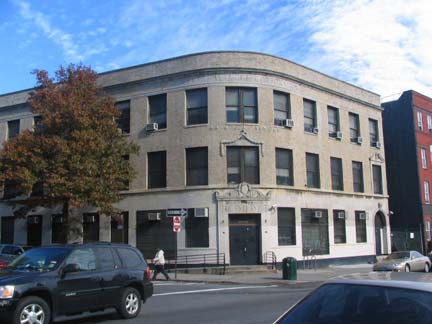
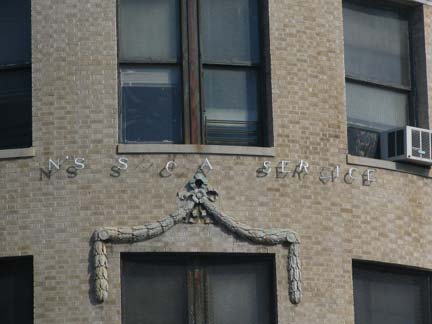
Waverly Avenue. The chiseled sign above the door identifies the building as Rubel’s Coal and Ice, though it has changed names in the past. The building is apparently now a rehab center and is very securely locked up.
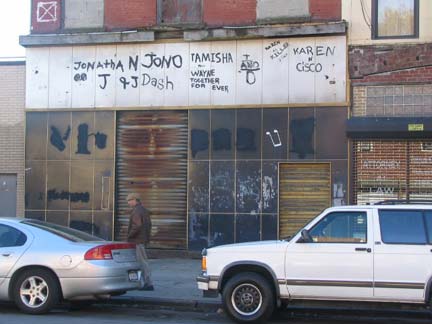
East of Washington Avenue we begin to enter Bedford-Stuyvesant. Apparently this was a social club or nightclub and originally featured a motif of musical notes on a staff on the linoleum facing. Someone has erased all the notes, except one.
Is the graffitist invoking the cancelled “Karen Sisco” cop show? Or did ABC get the name of the heroine from this old storefront?
Note the boxed “X”: this marks a caved-in floor, dangerous conditions and instability on the interior. The building will likely be demolished in the near future.
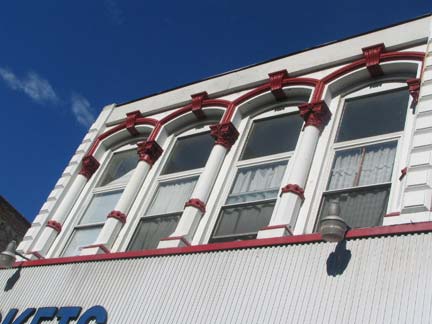
No matter how much modernization creeps in…keep looking up! Some surprises may show up, like an apparently carefully-maintained red and white façade that shines above a drabber street entrance.
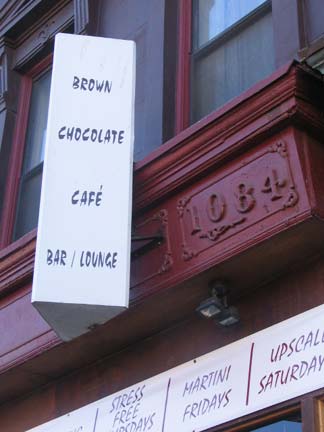
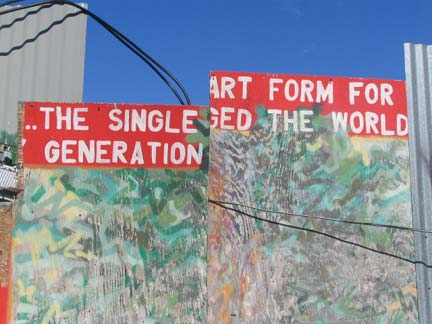
Near Classon Avenue: Brown Chocolate Café: sounds a bit redundant. Interestingly, the font used on the sign is called “Choc” by some foundries. I was attracted by the ornate street number and façade.
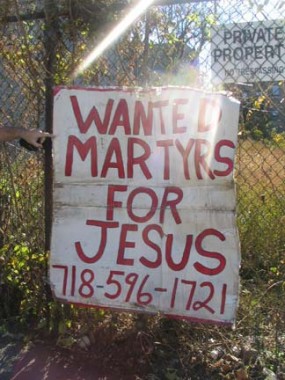
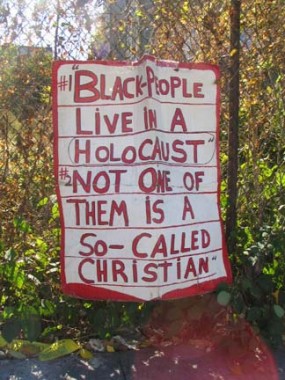
Near Classon Avenue.
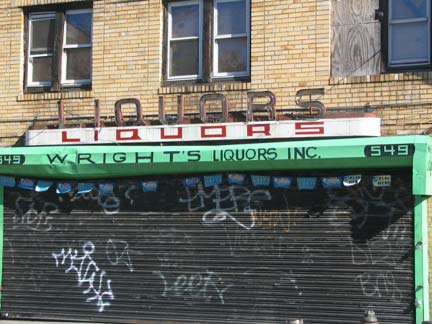
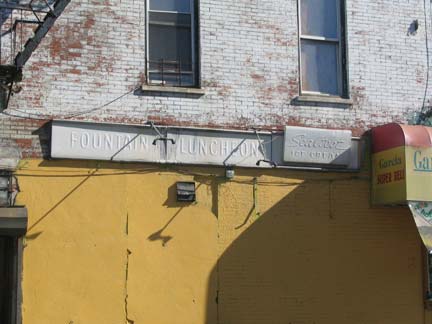
The vicinity of Classon Avenue seems to be a locus for ancient signage. Liquor stores throughout the city preserve old neon and painted signs, and Bedford-Stuyvesant is especially good for spotting them. Sealtest has been in business for over 100 years and got its start as the St. Louis Dairy Company in that city in 1897.
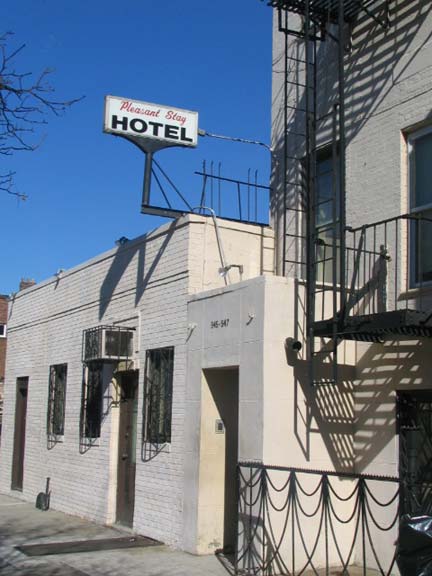
Classon Avenue
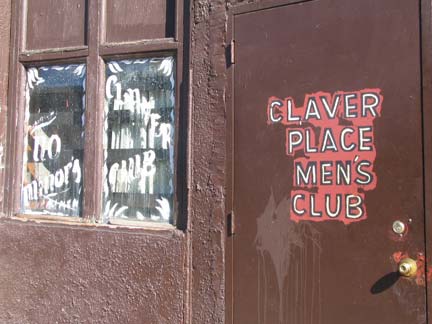
Claver Place
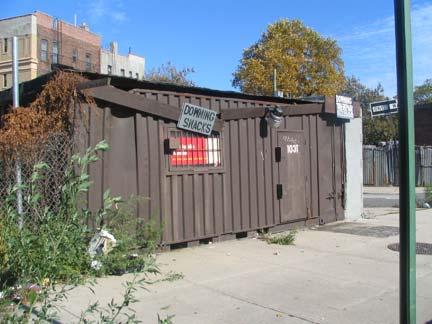
Downing Place
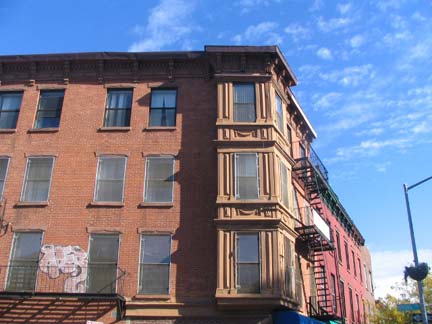
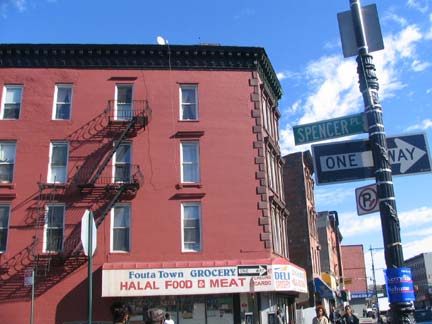
Fulton Street is an amalgamation of several roads of the colonial era. West of Flatbush Avenue, it follows the path of old Kings Highway; east of there, it is roughly a version of the old toll road, the zig-zagging Brooklyn and Jamaica Turnpike. Though the turnpike was straightened into modern Fulton Street by the mid-1800s, it runs slightly askew to its neighbor streets, creating several traffic triangles, and meets its cross streets at obtuse angles. Therefore, several interesting building shapes are produced, which photograph well in mid-autumn sunshine.
Above left, Irving Place; below, Spencer Place
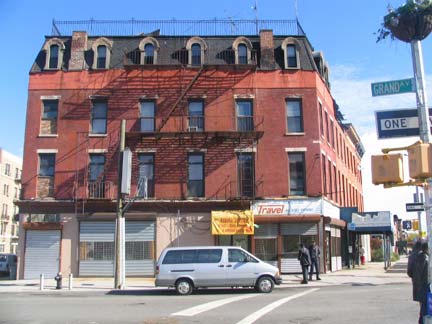
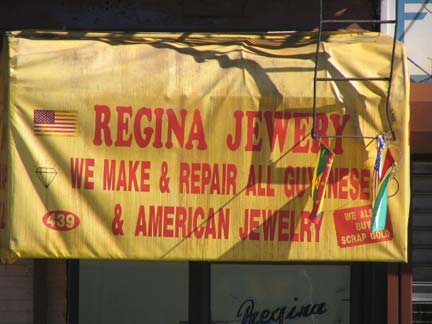
Detail from Grand Avenue storefront:
Fulton Street has many jewelry stores, the proprietors of many of which cannot spell “jewelry” correctly. In fairness, Americans and Brits cannot agree: in England, it’s “jewellery.”
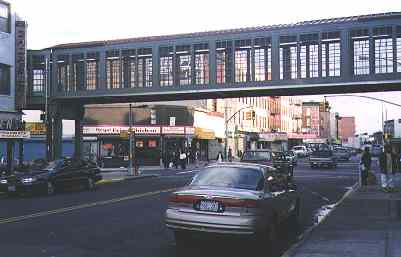
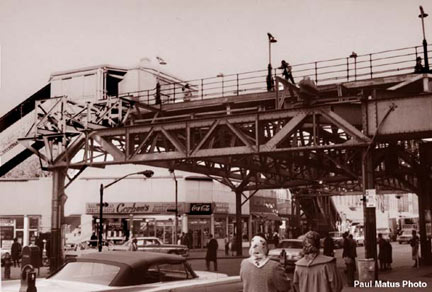
Fulton Street at Franklin Avenue, 2004 and 1965.
Until 1998, you had a chance to see a true Fulton Street “living fossil” since a small piece of the Fulton Street El, built in 1888 and mostly closed in 1940, was retained here to facilitate a transfer between the Franklin Avenue Shuttle and IND service below Fulton. The Shuttle once carried trains from Manhattan via the Brooklyn Bridge and Fulton Street to a junction with the Brighton Line, while some routes continued on to Coney Island. The Franklin Shuttle was treated as the MTA’s red-headed orphan line for many years and was constantly threatened with extinction before funds were found to completely restore it in 1998, at the cost of this small piece of history.
![]() All About The Franklin: the Franklin Shuttle, yesterday and today
All About The Franklin: the Franklin Shuttle, yesterday and today


Bedford Avenue claims the title of longest street in Brooklyn, beating out other contenders like Fulton Street, Flatbush Avenue and Kings Highway (only streets whose entire runs in Brooklyn are eligible!) Like many long streets, it’s a combination of several shorter streets that were amalgamated under one name long ago. It runs from Greenpoint to Sheepshead Bay. The section in Bedford-Stuyvesant is a straightened version of the colonial Cripplebush Road, which was the main road of the old village of Bedford.
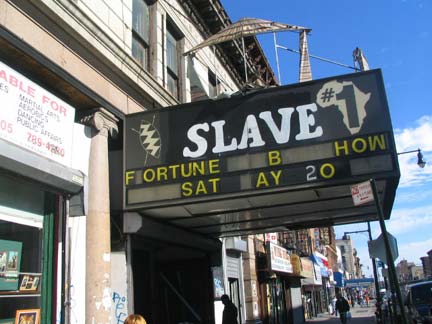
he Slave Theatre has been a hotbed for political controversy in the past; former Presidential candidate and MSNBC host Rev. Al Sharpton has lectured here. The theatre seemed like it hadn’t been used in awhile. Maurice Stewart and Ajax Real Estate are long gone.
Outside the Slave was a vendor apparently selling fragrances in small jars. Several were unfamiliar; one was labeled “pussy.”
I did not inquire what it could have been.
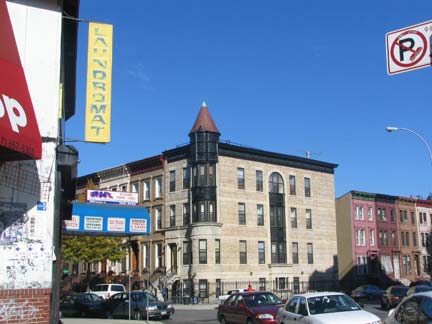
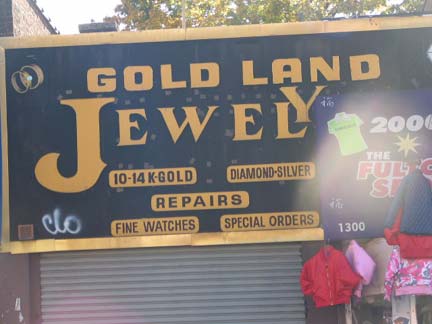
Arlington Place produces one of Fulton Street’s odd vistas as it gives rise to Macon Street, allowing a view of one of Bedford-Stuyvesant’s many cupolaed buildings.
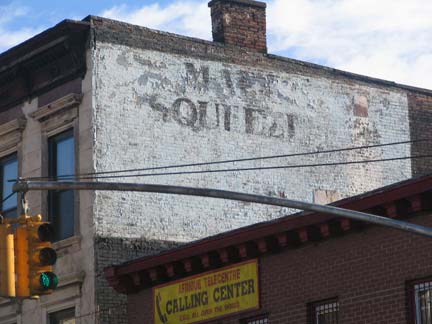
Main Squeeze was probably a clothing store.
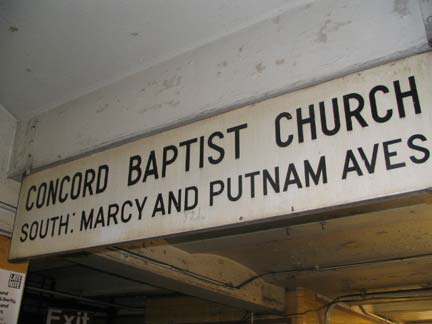
The Nostrand Avenue subway stop has an ancient sign advertising the Concord Baptist Church. At Marcy and Putnam is a more famous building: Boys’ High School.
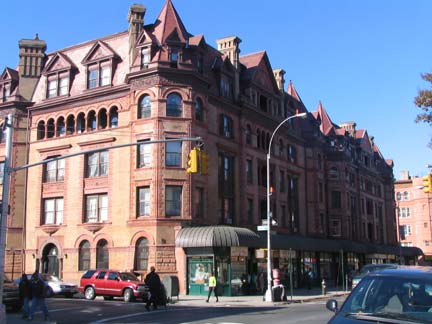
The Alhambra Apartments, on Putnam between Macon and Halsey Streets, just north of Fulton, is just a teaser of the many wonderful late 19th-Century buildings to be found in the heart of Bedford-Stuyvesant.
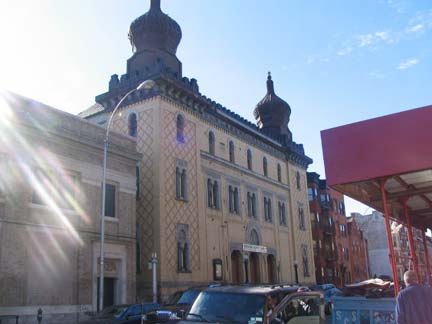

The Friendship Baptist Church, on Herkimer just west of Nostrand a block south of Fulton, was built in 1910. The crescent and star carved above the door are symbols of the Shriners, a branch of Freemasonry.
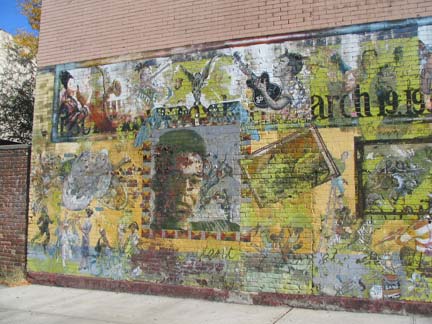
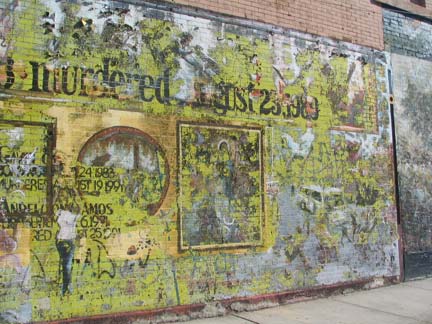
Mural on Verona Place likely eulogizing 16-year-old Yusuf Hawkins, who, on a visit to Bensonhurst, Brooklyn on August 23, 1989 was set upon by a gang of 30 whites and beaten and shot to death. Eight people were tried for the attack; three went to prison; two others were convicted but given probation; three were acquitted; only Joey Fama, the gunman, remains imprisoned.
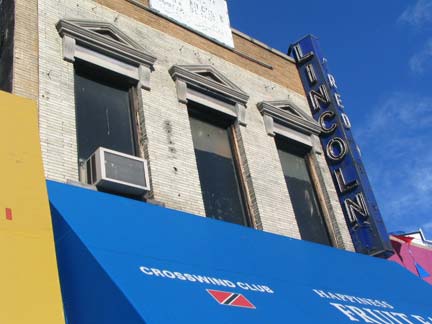
“Lincoln Credit” old neon near Verona.
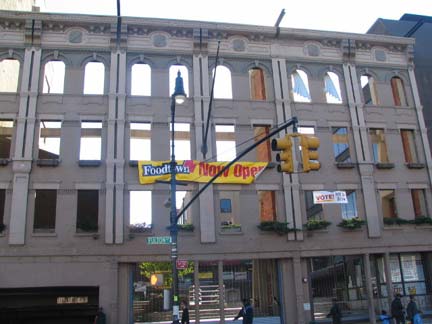
Restoration Plaza, on Fulton between New York and Brooklyn Avenues, a cultural and commercial axis in Bedford-Stuyvesant, houses 65 small businesses, the Billie Holiday Theatre, Skylight Gallery, Restoration Dance Theatre, College of New Rochelle, and Empire State College.
2004: The hollowed-out façade on Fulton opposite Tompkins Avenue will be rebuilt in the interior as a Foodtown Supermarket.
Restoration Plaza first appeared in 1976 in a former milk bottling plant; the AIA Guide to New York compares it to San Francisco’s Ghirardelli Square.
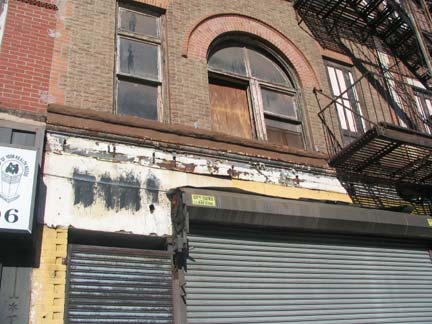
Faintly seen on an old storefront sign beside the closed gate are the Hebrew letters that, I’m told, spell out “Yahweh”, though please tell me if I am wrong; the letters are a mute testimony to Bed-Stuy’s former status as a Jewish neighborhood.
A few blocks south of Fulton, on Kingston and Bergen Streets, is the magnificently Moderne Kingston Lounge, a former jazz hotbed. The detail as well as red and black glass panel coloration are astounding.
In Crown Heights, East New York, and Flatbush, north-south avenues are named for New York State cities: New York, Brooklyn, Kingston, Albany, Troy, Schenectady, Utica, Rochester and Buffalo, and an additional one a few blocks east, Saratoga.
![]() More Kingston Lounge in FNY
More Kingston Lounge in FNY
![]() Ian Ference’s Kingston Lounge blog
Ian Ference’s Kingston Lounge blog

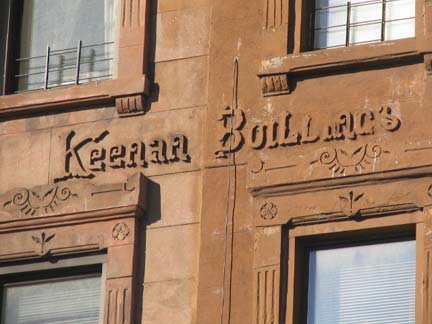
Albany Avenue: The circa-1900 lettering apparently says “Keenan Buildings” and since the sign straddles the two structures, that’s what they indeed are.
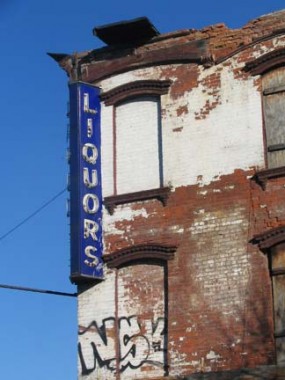
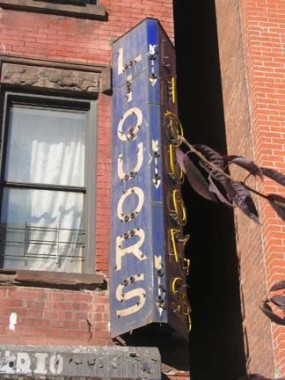
Two more venerable liquor neons, the first at Kingston Avenue at Pacific and the next at Fulton and Albany.
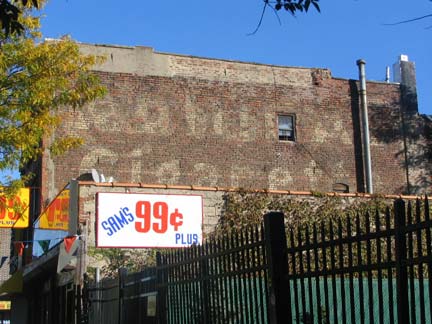
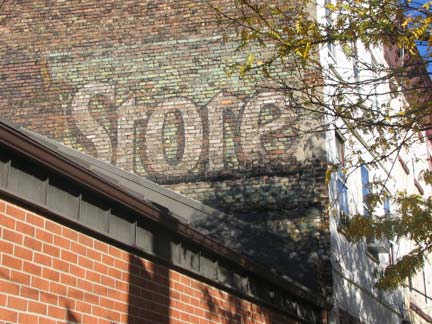
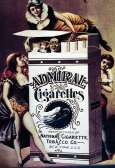 Two ancient ads near Utica Avenue/Malcolm X Blvd.: the first is for Admiral Cigarettes, the second is lost to history; and a magnificent spired church, whose name I’ve forgotten. The further east you proceed on Fulton, the more storefront churches you encounter; past Utica, most storefronts are churches.
Two ancient ads near Utica Avenue/Malcolm X Blvd.: the first is for Admiral Cigarettes, the second is lost to history; and a magnificent spired church, whose name I’ve forgotten. The further east you proceed on Fulton, the more storefront churches you encounter; past Utica, most storefronts are churches.
Showgirls help sell Admiral Cigarettes in an 1890s ad. In 1895, Admiral produced the first filmed advertisement.
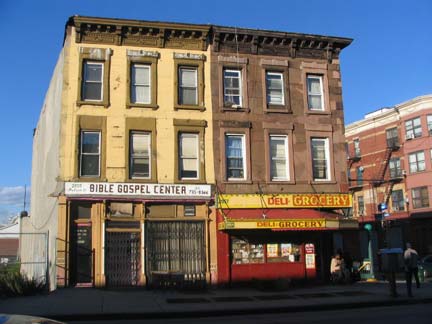

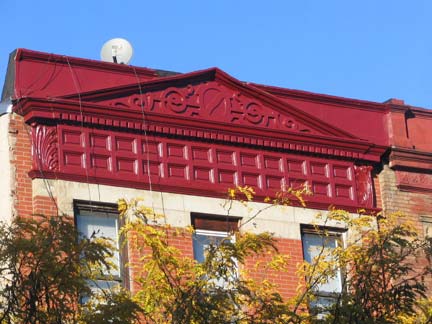
Near Rockaway Avenue the storefronts and brownstones get scarce as Fulton turns residential, with more two-family homes appearing. The brownstones resurge at Rockaway; here is some detail from a building front.
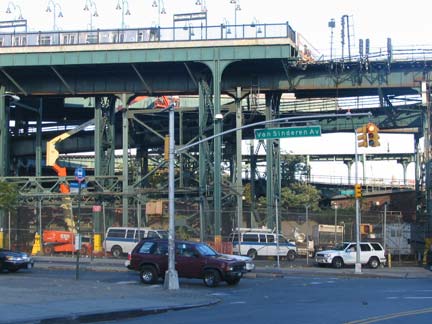
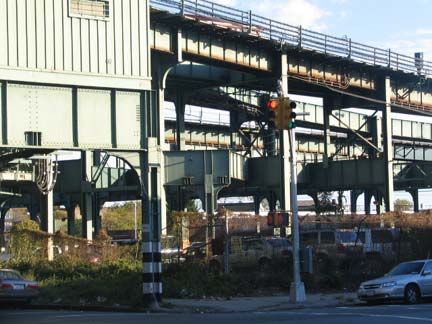
Van Sinderen Avenue: the vast East New York/Broadway subway junction is where the elevated Canarsie (L) and Jamaica (J, Z)-bound trains intersect. Additional ramps connect both lines to the East New York subway yard, and a transfer to the underground IND Fulton St. subway is also available. If anything, the ENY junction was even more complicated when the Fulton Street El ran here: it ran all the way to Rockaway Avenue until 1950, when it was cut back to a section in Queens that connects with the IND at the Euclid Avenue station. A short stub of the el, mostly hidden and anonymous, remains at Fulton and Van Sinderen.
Street necrology buffs: Van Sinderen was called Vesta Avenue until the early years of the 20th Century. I don’t know how the name change happened; perhaps Vesta was the name of a local firm. It’s likely Van Sinderen was the actual original name. It has always been dominated by the Canarsie railroad, which ran at grade when built, and was later elevated and then connected to the BMT Subway, today’s L line.
Street name changes have accelerated in recent years as streets were named for local heroes and heroines. Stone Avenue became Mother [Rosetta] Gaston Boulevard; Hopkinson Avenue became Thomas Boyland Street; and Pennsylvania Avenue is subtitled Granville Payne Avenue. Sumner Avenue became Marcus Garvey Blvd. and Reid Avenue is now Malcolm X Blvd, and in the dim past, the East New York section of Linden Blvd. was called Vienna Avenue.
Your webmaster shot photos for this page October 31 and completed the page November 14, 2004.

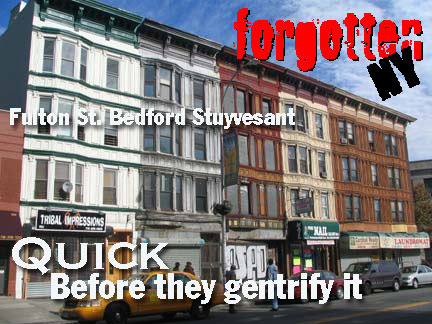
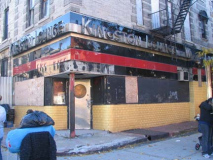
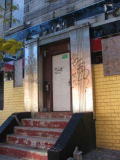
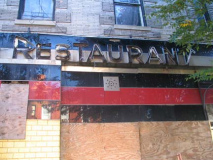
1 comment
I wish I saw photos of the old Paragon Building, I lived across the street from! The Apollo Theater at Fulton and Throop,Kingston And Fulton St had The Crystal Market grocery store, and Nats Record Shop! And the leopard
lounge bar. Too many memories of businesses I grew up with on fulton st
to post.